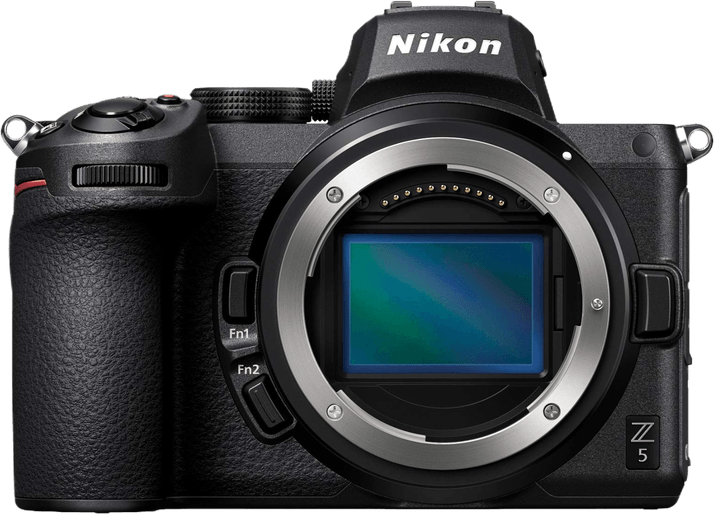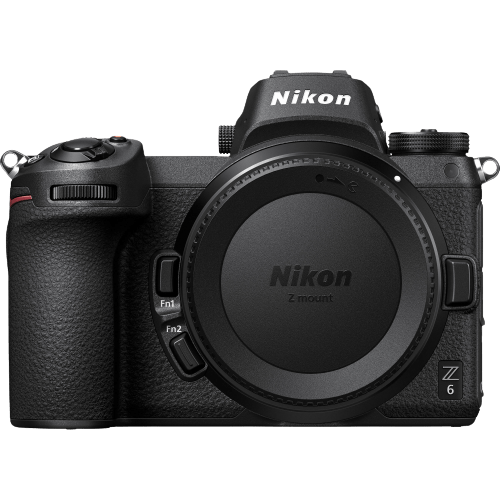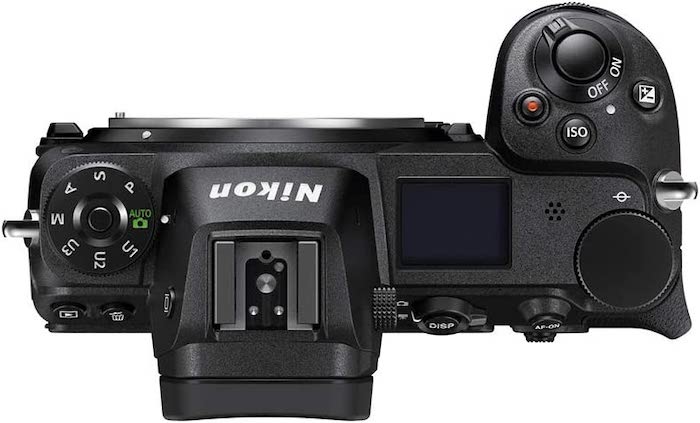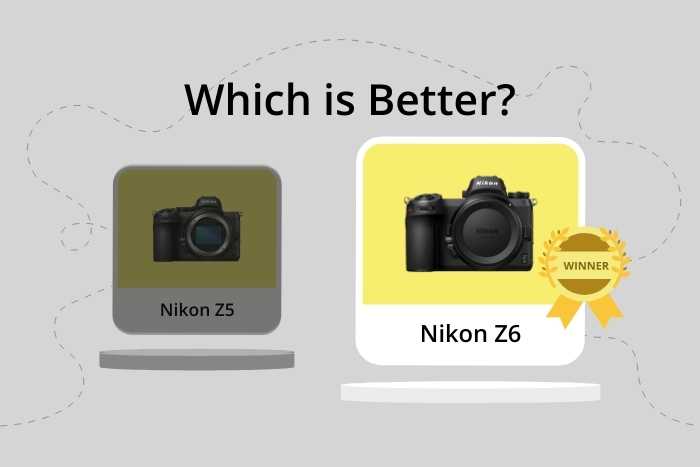Nikon Z5 vs Z6 Comparison
Nikon Z5

Nikon Z6

Nikon Z5 vs Z6 Overview
These are very similar full frame mirrorless cameras—as the names suggest. That means, with any Nikon Z5 vs Z6 comparison, you have to search hard for the differences.
The Nikon Z5 came out a couple of years later than the Nikon Z6. It has slightly better batteries and costs a bit less.
However, the Nikon Z6 is the better in the following areas:
- Image sensor
- Low-light performance
- Continuous shooting speed
- Boosted ISO range
- Memory cards
- LCD resolution
- Video capabilities.
- It also has a small LCD on top of the camera body, which is missing on the Z5.

Nikon Z6
Nikon Z6 Pros and Cons
- Excellent high-ISO performance
- 4K video and time-lapse features
- Accurate AF system with eye detection
- Weather-sealed body
- 120 fps slow-motion video
- Frustrating buffer capacity
- Only one memory card slot
- Short battery life
Nikon Z5 Pros and Cons
- Fantastic expandable ISO range for low-light shooting
- Brilliant 273-point AF system
- In-body 5-axis image stabilization
- High-resolution electronic viewfinder
- Limited 4.5 fps burst with AF support
- Autofocus loses accuracy in low light
- Fewer Z-mount lenses than F-Mount
- 4K video is cropped
Body and Handling
Cameras are a lot like cars these days. There are a lot of similar models based on the same basic design. The Nikon Z5 and Z6 are two cameras that show this perfectly.
They look almost identical, but the Z6 is only 2 mm thinner and 5 g lighter. Both are more compact than Nikon DSLRs and handle well due to their large grips.
They also have the same Nikon Z-mount. So you can use the same lenses with both cameras. In fact, you can even use F-mount lenses if you get an FTZ adapter.
The only differences in ergonomics and usability are in the screens and dials. The top of the Nikon Z6 has the mode dial on the left and a small LCD screen on the right. The rear LCD is also better than the one on the Z5, with more than double the resolution (1,040K dots vs 2,100K dots).
The Nikon Z5 has the mode dial on the right-hand side. This means there’s no room for an LCD screen on top. That’s a pain if you like checking your aperture, shutter speed, and exposure compensation settings on-screen. However, whether the dial should be on the left- or right-hand side is just a matter of personal preference.
It’s also worth pointing out that neither camera has a built-in flash. But you can always use an external flashgun.

Optics
Both cameras have full-frame sensors with an Expeed 6 image processor. However, the Nikon Z5 has a 24.3 MP CMOS sensor, whereas the Z6 has a 24.5MP BSI-CMOS sensor.
The higher resolution of the Z6 sensor is not a significant difference. Both cameras offer excellent image quality. However, the BSI sensor (backside illuminated sensor) gives the Z6 the edge in dynamic range (-3.5 to +19 EV vs -2 to +19 EV). This means it’s better in low light.
Their native sensitivity range is the same. But the Z6 has a higher expanded ISO limit (204,800 vs 102,400). So it’s even better suited for darker environments.
Another significant difference is their burst rates. The Nikon Z6 can be more adept at capturing action shots at 12 fps. It’s something worth considering if you’re taking wildlife or sports photos.
Nikon Z5 vs Z6 Video Performance
The Nikon Z6 is better for shooting video. It uses the full sensor width in 4K up to 30 fps and 1080p up to 120 fps.
Video shooters will also like that the Z6 can shoot 10-bit N-Log with HDMI output. This gives a better dynamic range and helps with color grading. (The HDMI output means you’re using an external recorder, not the memory card.)
The Z5 has a 1.7x crop when shooting 4K videos. And it can only shoot 4K up to 30 fps or 1080p up to 60 fps. It’s not an ideal setup for vloggers.
Nikon Z5 vs Z6 Features and Benefits
Both cameras share the vast majority of the available features. I’ve counted 24 areas where the specifications are identical. They include the following:
- Wireless and Bluetooth connectivity
- External microphone and headphone ports
- Weather sealing
- Sensor-shift image stabilization
- A tilting LCD screen
- RAW file support
- Eye detection AF
Apart from slightly more resolution and better performance in video mode, the main advantage of the Z6 is the higher frame rate.
The Nikon Z6 can shoot at 12 fps. But the Z5 can only manage 4.5 fps. That might be a deal-breaker for many photographers who take a lot of action shots of fast-moving subjects.
Nikon Z5 vs Z6 Storage and Battery
The Nikon Z5 and Z6 take different approaches to storage space.
The Nikon Z5 has dual memory card slots that take SD (Secure Digital) and UHS-II compliant SDHC and SDXC memory cards. However, the Z6 has only a single XQD card slot. But it can also take CFexpress Type B cards if you upgrade the firmware to version 2.20 or later.
There are two sides to this argument—convenience vs performance. The Nikon Z5’s dual card slots are very convenient. There are two of them, and most people already have SD cards. That means you won’t have to buy a more expensive XQD or CFexpress Type B card.
However, XQD and CFexpress Type B cards are much faster than SD cards. And they are available with more capacity.
These both improve the buffer rate of the Nikon Z6. And it makes it much quicker to transfer files to your computer for post-processing. We have an article explaining different memory card types if you want to go deeper!
The Nikon Z5 boasts significantly better battery life than the Z6 (390 shots vs 310 shots using the viewfinder). However, based on my experience with the Sony a1, these numbers will probably improve when shooting in burst mode.
Nikon Z5 vs Z6 – Our Verdict
Overall, the Nikon Z5 and Z6 are very similar products. Both offer a bundle of impressive specifications typical of modern, mirrorless, full frame cameras:
- Excellent image quality
- A bright electronic viewfinder
- AF tracking
- Wireless connectivity
- External ports
- Weather sealing
- In-body image stabilization
The Z5 has a better battery life, features dual SD card slots, and is more affordable (at the current price).
However, the Z6 is much better in terms of low-light photography, burst shooting, serious video capabilities, storage, and LCD resolution. And that all makes the Nikon Z6 our preferred camera in our Nikon Z5 vs Z6 comparison.

Nikon Z6
Nikon Z5 and Z6 Alternatives
Still not sure? Check out our other popular camera comparisons:

